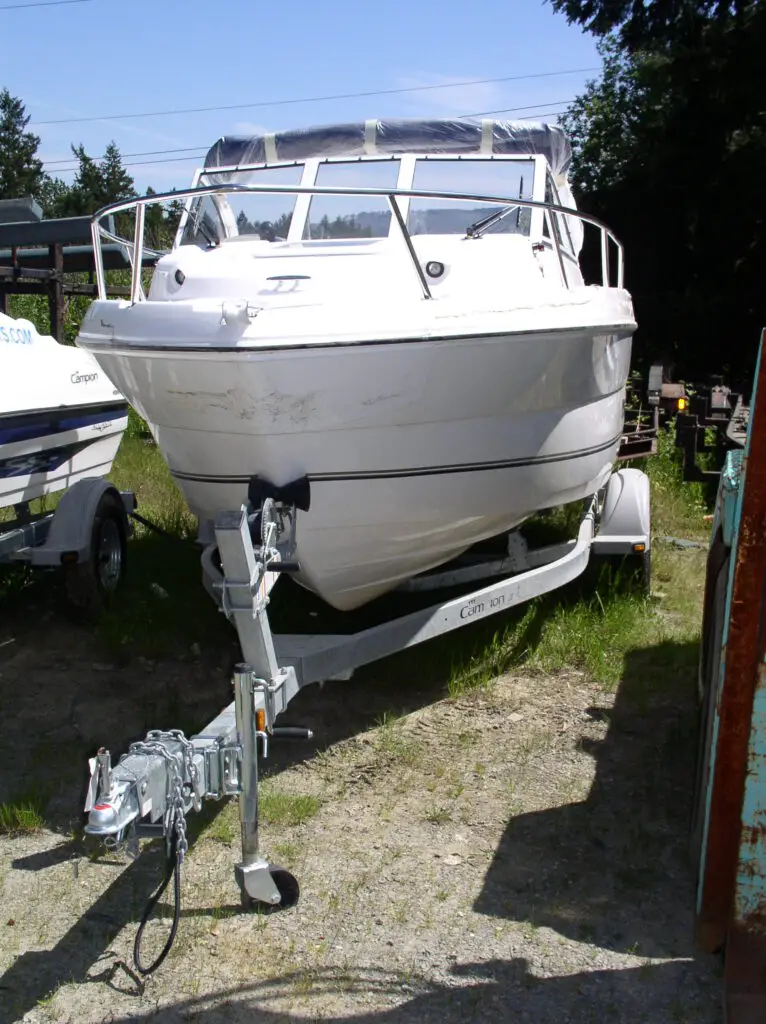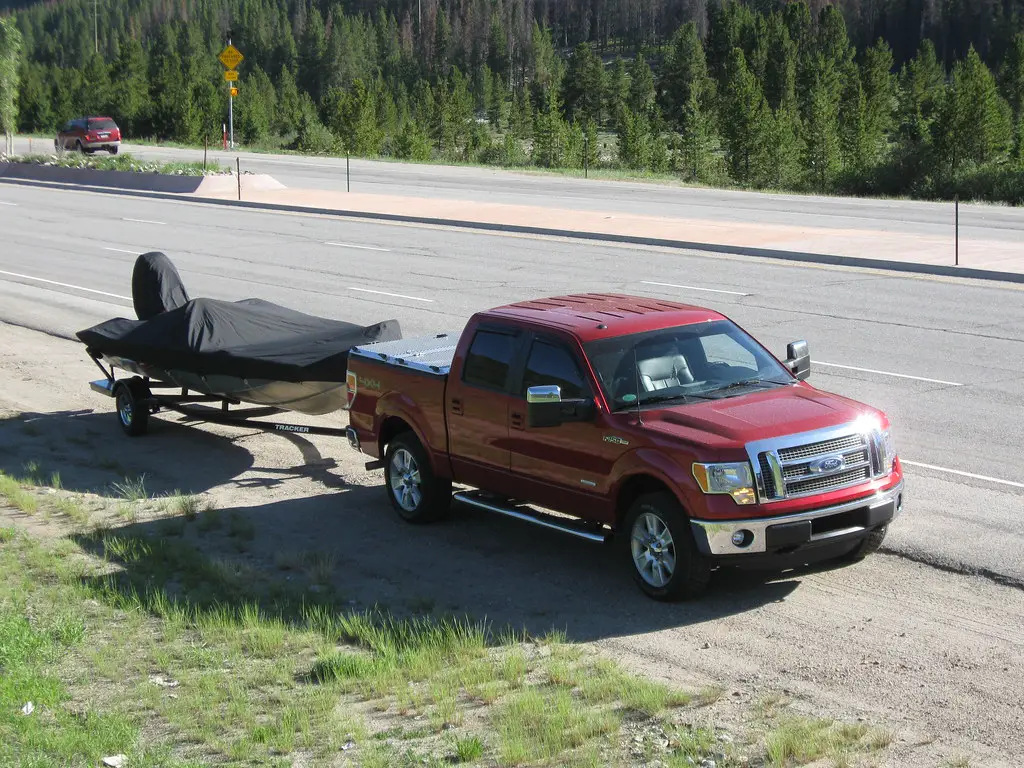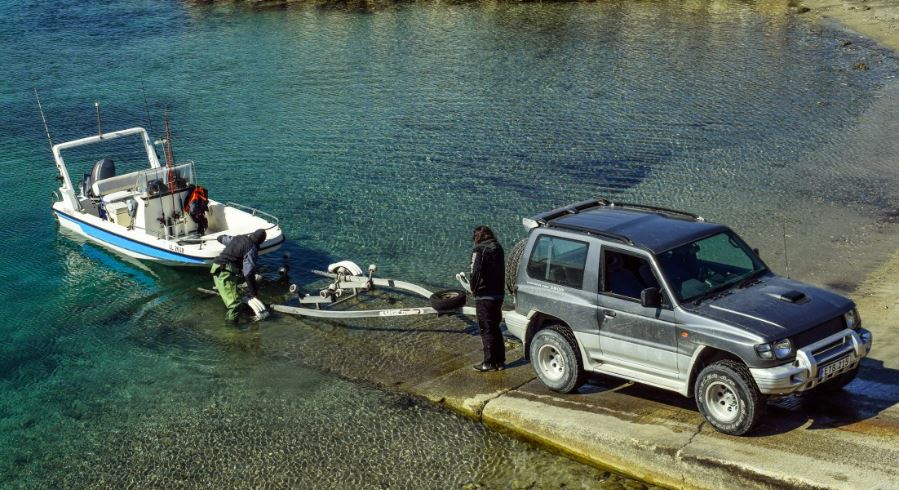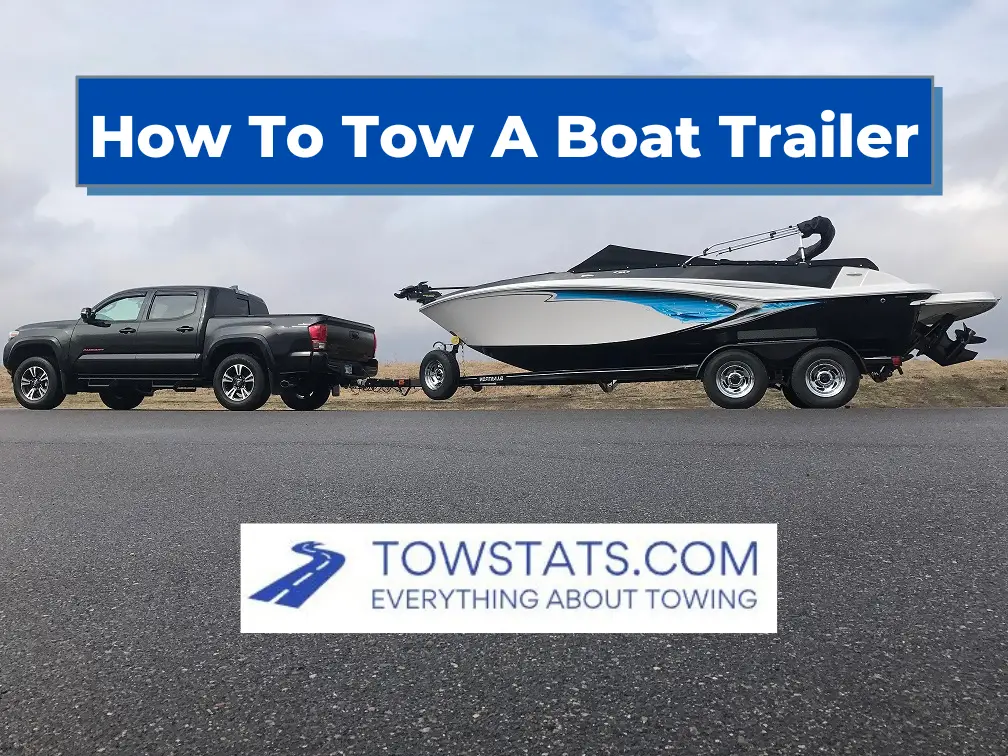If you just got your first boat or are considering one, learning how to tow a boat trailer is going to be one of your main priorities.
Boat trailering can seem complex at first, but it’s actually rather simple.
In this guide, we’ll provide some easy tips on how to pull your boat trailer safely so you can feel confident while on the road and have an easy time when you get to the ramp.
How To Tow A Boat Trailer
Towing a boat trailer is very similar to towing nearly any other type of trailer, with the main difference being the size and weight of the boat.
That size is going to cut down on your visibility on the road and can make the lane you’re in feel pretty tight.
In addition, the weight of the boat is going to require some changes in driving habits when boat trailering so you can do it safely.
Let’s go over all the key aspects you need to pay attention to when pulling your boat on a trailer.
Before You Go

Make sure you’ve got all the necessary equipment you’ll need to safely tow your boat.
Check Your Vehicle’s Towing Capacity And Gross Trailer Weight (GTW)
At the highest level, this will mean knowing what your boat and trailer weigh (the Gross Trailer Weight or GTW) and ensuring that the GTW doesn’t exceed your vehicle’s towing capacity.
This step is usually figured out before you buy the boat, but we thought we’d mention it just in case.
Make Sure You’ve Got The Right Hitch
There are many different types of trailer hitches out there, but the most common type is a rear receiver hitch.
There are different trailer hitch classes for receiver hitches, and each one usually has a different receiver hitch size that will accept different towing accessories.
The most common type of hitch accessory you’ll use to pull a boat trailer will be a ball mount.
Confirm Your Coupler And Trailer Ball Match
Be sure to measure your boat trailer’s coupler size to confirm that you have the right trailer ball size to pull it properly.
Never use a trailer ball that doesn’t match up perfectly with the trailer coupler!
Do You Need A Weight Distribution Hitch For Your Boat Trailer?
If your boat trailer weight is over 5,000 lbs or exceeds more than half of your vehicle’s weight, you may also need a weight distribution hitch to prevent trailer sag and have a safer ride.
Again, a weight distribution hitch or other hitch stabilizer device should have been addressed when you purchased the boat, but not all dealers do the job properly.
Get To Know Your Boat Trailer
If you aren’t already, this is a good time to get fully familiar with all the parts of a trailer hitch.
Also know where to place your trailer jack, as doing it in the wrong spot can bend the trailer frame.
Each trailer has it’s own specific spot, so take a look through the owner’s manual to save yourself some trouble.
Check Your Tire Pressure
Look at your tow vehicle owner’s manual and your boat trailer’s manual to confirm you have the right tire pressure for towing.
If the tire pressure is too high you could risk blowing out a tire, and you can risk wearing down your tires and an unsafe ride if the pressure is too low.
Load Up Your Boat Trailer
If you’re headed out on the water, chances are you’ve got plenty of gear like life jackets, innertubes, and other stuff you’ll need.
Most of this is lightweight and will fit in your tow vehicle, but some folks like to throw it in the boat to free up space.
If doing so, make sure to secure it so it doesn’t go flying out while you’re towing your boat, and ensure that you know how to load a trailer to balance the weight properly for safety’s sake.
Make Sure You Have A Spare Trailer Tire
A cardinal sin of boat towing is leaving home without a spare tire for your trailer.
Ever see a loaded boat trailer abandoned by the side of the road?
Don’t let that be you!
Always make sure you have a properly inflated spare trailer tire along with the proper tools like a jack, wrench, and anything else you may need to ensure you can change a trailer tire on the road.
Connect The Boat Trailer To Your Tow Vehicle
A boat trailer is a heavy piece of equipment, so some precautions will be necessary when connecting it to your vehicle to avoid damage to the trailer, your vehicle, and the boat.
Make certain you know how to hook up a trailer and double check everything.
This usually involves backing up the vehicle to the trailer, connecting the trailer coupler, retracting the trailer jack, connecting the trailer wiring to your vehicle, and doing a final check of the connection.
Connect Your Safety Chains
Safety chain laws require the use of at least one and typically two safety chains in most states.
Make sure you know how to hook up safety chains to a trailer properly, as they keep your trailer connected to your tow vehicle in the event that your boat trailer coupler fails during transport.
Although it isn’t a law to cross safety chains in most states, it’s a very smart idea to do so and can help prevent additional damage if your trailer disconnects from your vehicle on the road.
Do A Final Check
Make sure your brake lights, hazard lights, running lights, left turn signal, and right turn signal are all working properly before heading out.
If you have a brake controller for your trailer brakes, now’s the time to get it properly calibrated and test the brake system to confirm it’s also operating as it should.
On The Road

Like most things in life, preparation is key, which is what the previous section was about.
Now let’s cover the main things you need to keep in mind while towing your boat on the open road.
You can take a look at our towing safety tips guide for some general pointers before you hit the road, but we’ll go into the specifics about towing boats right here.
Wait To Fill Up
Waiting to fill up your boat’s fuel and water tanks until you’re close to your destination will reduce the amount of weight your towing.
This will increase braking and accelerating efficiency increase your fuel economy while boat trailering.
Use Your Side View Mirrors
Your rear view mirror won’t be of much use when towing tall or large boats, so you’ll need to rely on your side view mirrors to gauge distances for passing or changing lanes.
Accelerating And Stopping
Be prepared for your tow vehicle and trailer to take longer to accelerate and stop when pulling the heavy weight of a boat.
You’ll need to keep this in mind when passing other vehicles, pulling out into traffic, and slowing for traffic lights or turns.
Give yourself extra distance between your vehicle and the vehicles in front of you for safe braking and when passing.
When going downhill, you can downshift to a lower gear rather than riding your trailer brakes to keep control of your speed.
Speed Limits
Although you should always obey the posted speed limit when towing, there may be a lower number you need to set your sights on.
Additionally, some states have special trailer towing speed limits that you need to obey and they may be lower than the signs you see on the highway.
Note that your trailer may also be rated for lower speeds, so consult the trailer owner’s manual to know your numbers.
Turning
Simply put, you will not have a tight turning radius when towing a boat on a trailer versus your vehicle on it’s own.
This means you’ll need to make wider turns than usual to avoid your trailer tires jumping curbs or getting damaged.
Try to put your vehicle on the outside of the lane to compensate for this extra space you’ll need.
Wind Considerations
You’ll certainly notice that wind has a greater affect on boat trailering than when your vehicle is on it’s own.
Gusts of wind or even the air waves created by semitrucks on the highway can literally push your rig to either side as the air moves around it.
Be ready to correct this by steering and always keeping both hands on the wheel.
Troubleshooting On The Road
Sometimes things can get rough out there, so it’s important to know how to correct towing issues before you’re in a bad spot.
If you start fishtailing or experiencing trailer sway while boat trailering, you can usually resolve it by steering as little as possible while gently slowing down your tow vehicle.
Try to avoid using your brake pedal if possible, and just gently coast down to somewhere between 25 and 35 mph to see if that fixes the trailer sway.
If steering is feeling off, you may have either too much or too little weight on the trailer tongue, which can throw everything out of whack.
If you’re already on the road, try to adjust items you’re storing in the boat towards the front of the trailer to correct it.
You can also experiment with winching the boat forward on the axle of your boat trailer to increase tongue weight for a smoother ride home.
Getting The Boat Off The Trailer

You’ve finally made it to the water and are ready to get your day started!
Here’s where knowing how to back up a trailer is going to pay off big time.
Here are the main things you should always do when backing up a boat trailer:
- Get out and inspect the ramp so you can come up with a game plan.
- Go back to your trailer and check the wheel hubs. If they’re hot, you may have a wheel bearing failure and need to get it checked out urgently.
- Try to back up in a straight line down the ramp if possible.
- Go slowly to make alignment errors easier to correct.
- Put your hands on the bottom of the wheel so you can easily “steer” the trailer.
- If you make an error, you can straighten things out easily by pulling forward.
- Use your mirrors and look over your shoulder for extra visibility.
- Have a helper guide the tow vehicle back, making sure you each can see each other.
- Always be fully aware of your surroundings (people, other vehicles, and trailers).
- Don’t remove the winch strap and safety chain until you’ve got the boat in the water. You don’t want your boat crashing onto the boat ramp!
- Once your boat is in the water, set the parking brake on your tow vehicle and get the boat off the trailer.
Getting Your Boat On The Trailer
Follow the above tips to back the trailer down the boat ramp until it’s positioned properly, and make sure to set the parking brake on the tow vehicle.
- Line the boat up with the trailer and idle up until it’s over the trailer bunks.
- Pull the boat forward until it touches the bow stop on the winch post, then clip the winch strap to the bow eye.
- Use the winch to finish pulling the boat until everything is tight.
- Once the boat is secure, pull it off the ramp and do a final inspection of your load and trailer lights before heading back home.
Once You’re Home
When you’re finally back from your day on the water, make sure to park your trailer and use wheel chocks to keep it from rolling away.
It’s also wise to invest in a trailer lock to keep your property secure.
There are several different ways to prevent trailer theft and you can combine a few of them with great results.
Finally, do a thorough inspection of the tow vehicle and boat trailer to make sure everything’s in great shape for your next adventure.
Frequently Asked Questions
Although there are no laws prohibiting you from towing a boat with the cover on, it’s not recommended.
Towing a boat with the cover on can fray and damage your boat cover, and the flapping cover can also cause scratches and scuffs on your boat.
Although many vehicle rental companies do not allow you to tow a boat with a rental truck, there are a few places that do.
Enterprise truck rental offers 1/2 ton and 3/4 ton pickup trucks that can be used for towing. You’ll need to supply your own ball mount and accessories to use with the receiver hitch.
Although it varies by location, UHaul allows you to tow a boat with a UHaul rental truck as long as you tell them first.
Towing a boat behind your fifth wheel trailer is called triple towing, and it’s only allowed in these states: AK, AZ, AR, CA, CO, CT, HI, ID, IN, IA, KY, LA, MO, MT, NE, NM, NC, ND, OH, PA, SC, SD, TN, UT, and VA.
There are specific guidelines for total length and weight of all vehicles that vary by state, so be sure to check the provisions for each state before towing a boat behind your fifth wheel.


